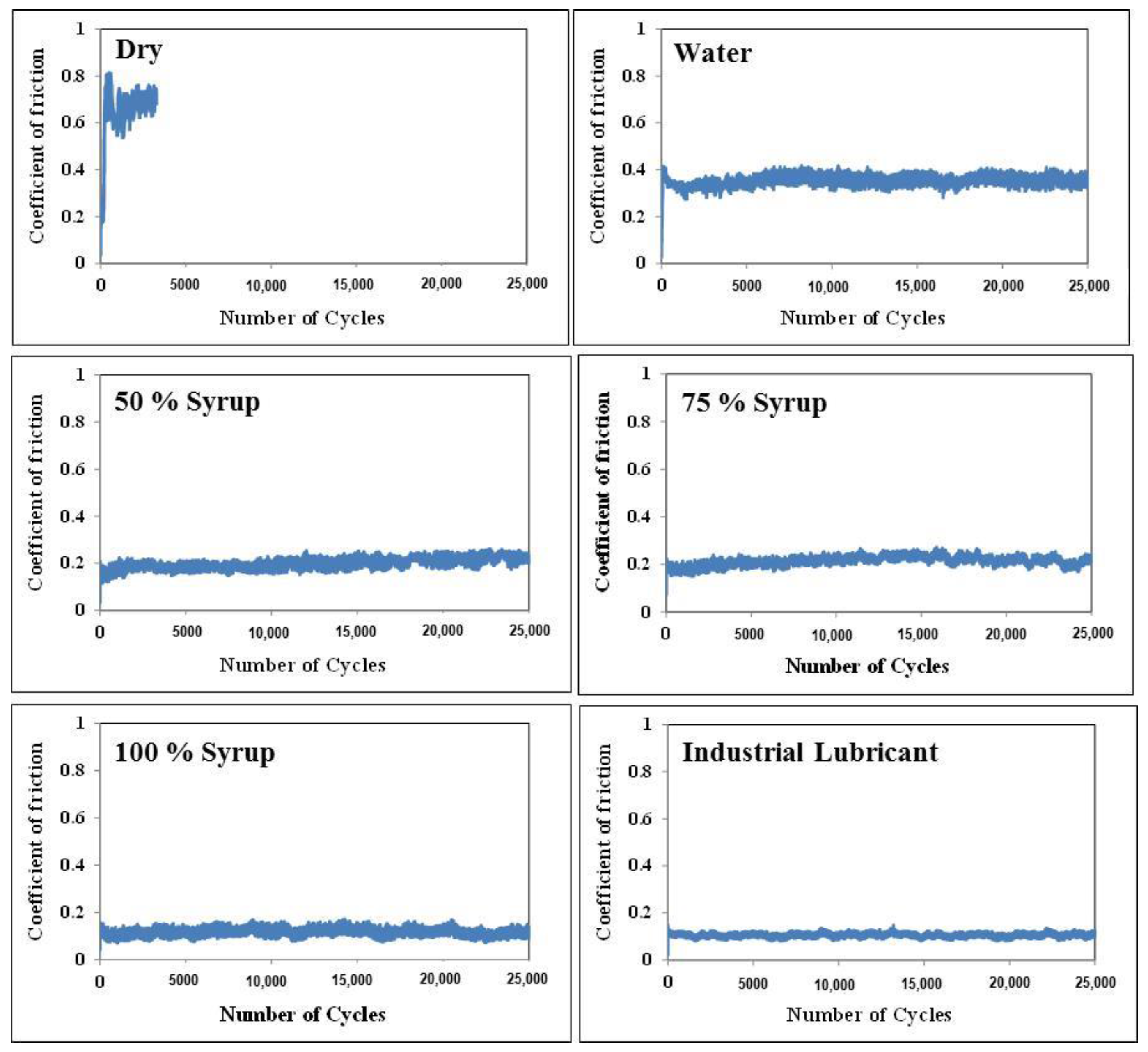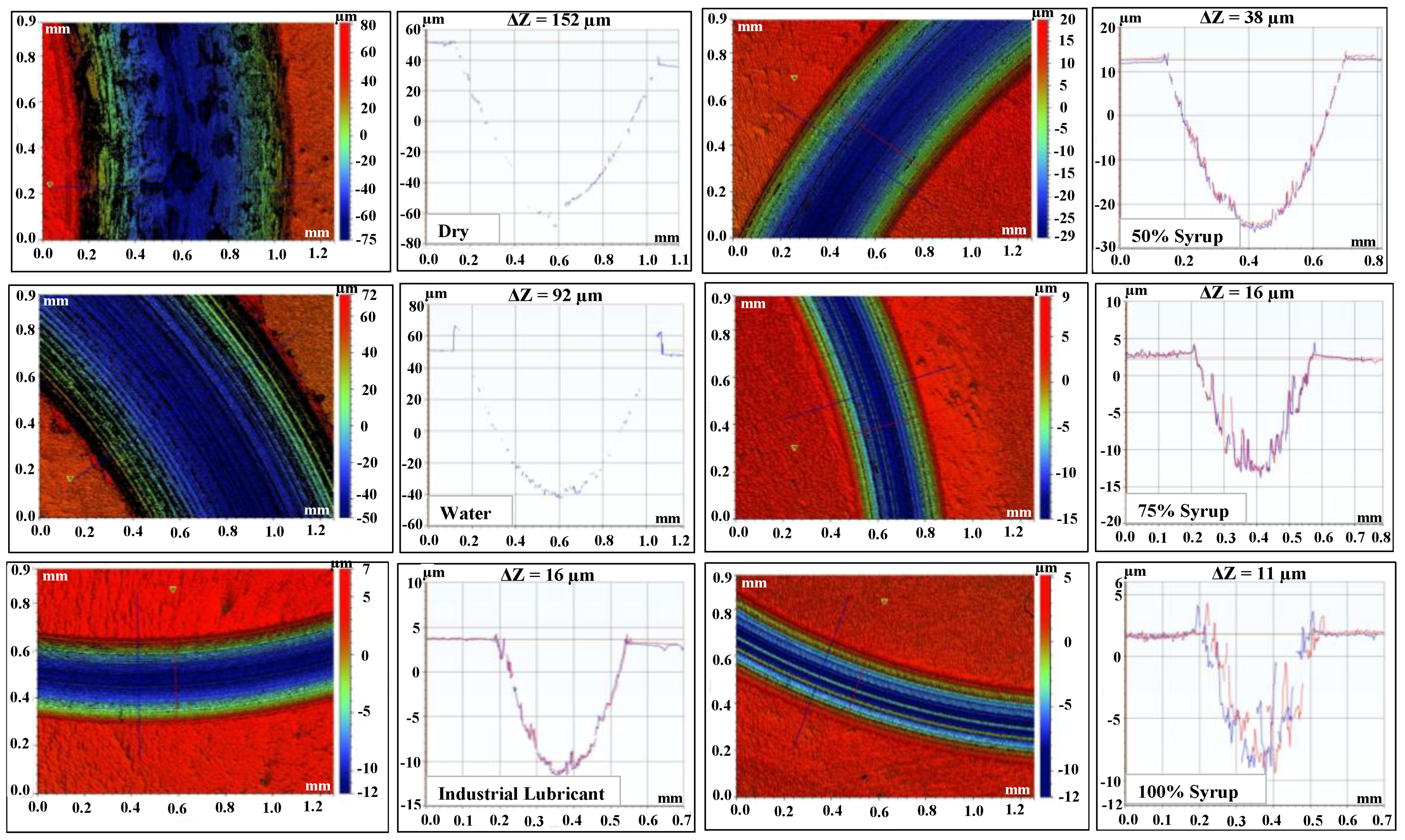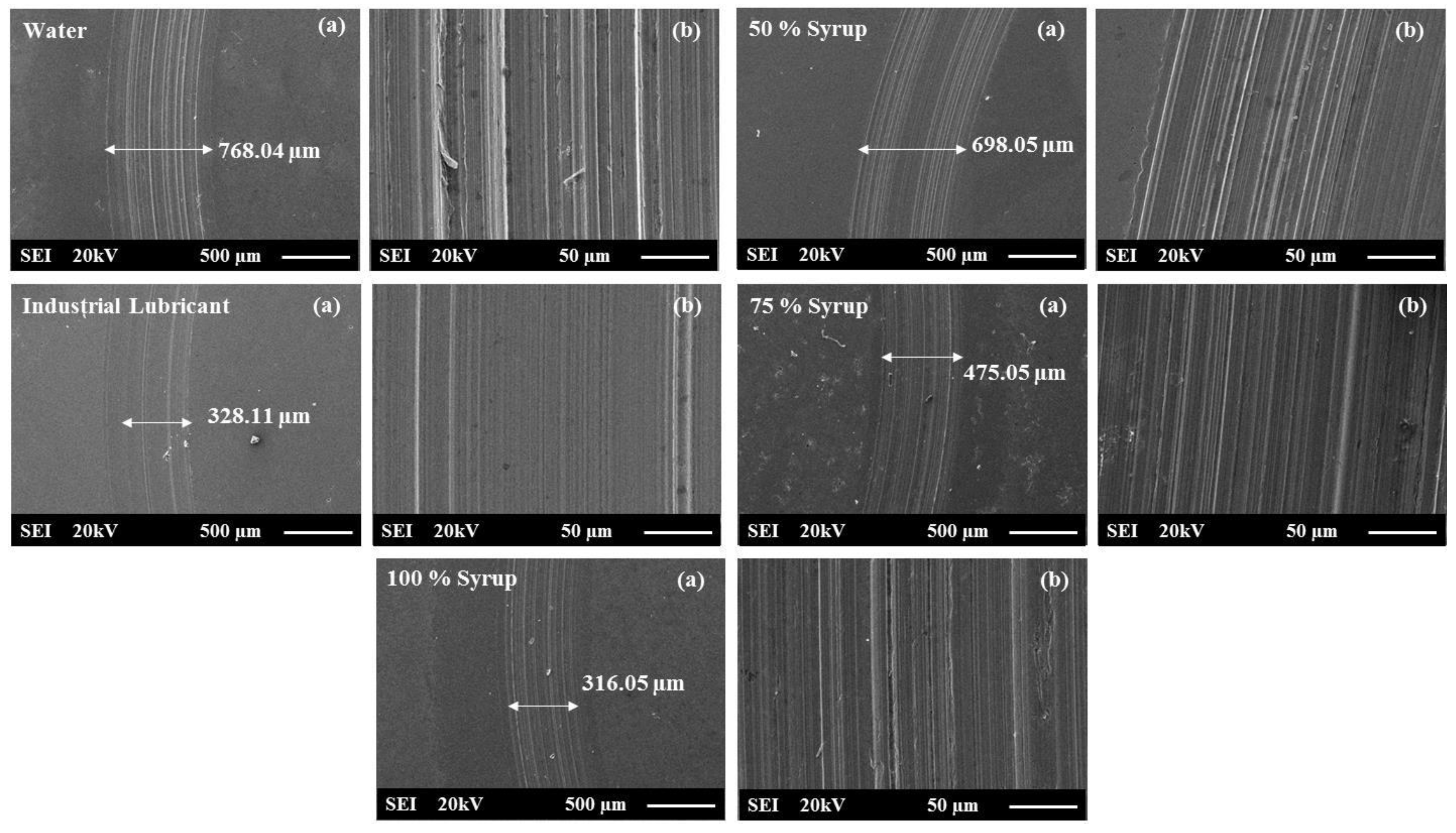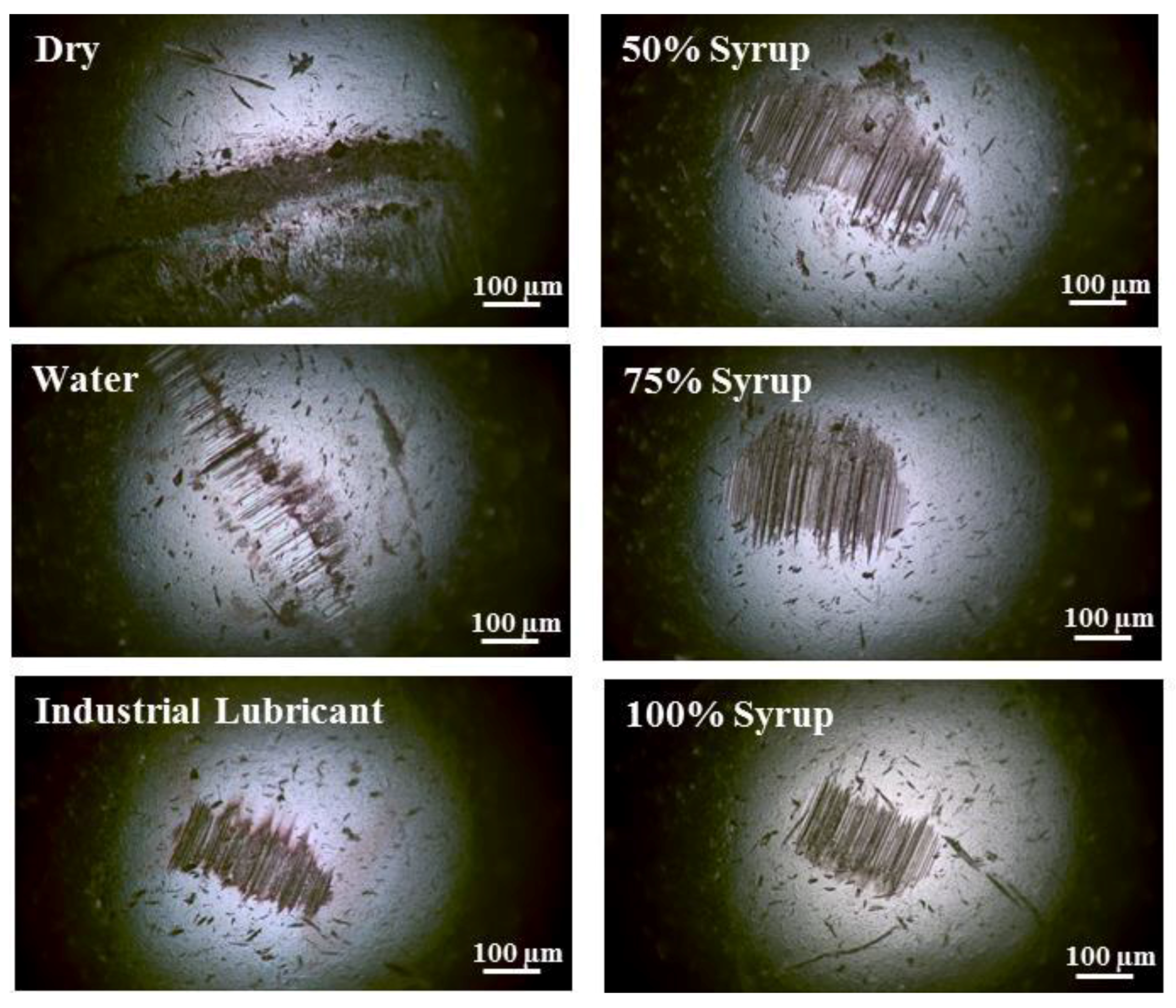Tribological Evaluation of Date Palm Fruit Syrup–A Potential Environmental-Friendly Lubricant
Abstract
:1. Introduction
2. Materials and Methods
3. Results
3.1. Variation of Coefficient of Friction under Different Solutions
3.2. Wear under Dry and Lubricating Conditions with Different Solutions
3.2.1. Effect of Different Syrup Loadings on the Wear of the Tribo-Pair as Compared to Dry and Water Lubricated Conditions
3.2.2. Effect of Different Syrup Loadings on the Wear of the Tribo-Pair
3.2.3. Performance of the Date Palm Fruit Syrup Solution as Compared to an Industrial Lubricant
4. Conclusions
Acknowledgments
Author Contributions
Conflicts of Interest
References
- Rizvi, S.Q.A. A Comprehensive Review of Lubricant Chemistry, Technology, Selection, and Design; ASTM International: West Conshohocken, PA., USA, 2009; pp. 100–112. [Google Scholar]
- Leslie, R.R. Lubricant Additives, Chemistry and Applications; Marcel Dekker, Inc.: New York, NY, USA, 2003; pp. 254–293. [Google Scholar]
- Ludema, K.C. Friction, Wear, Lubrication: A Textbook in Tribology; CRC Press L.L.C.: Boca Raton, FL, USA, 1996; pp. 124–134. [Google Scholar]
- Vazquez-Duhalt, R. Environmental impact of used motor oil. Sci. Total Environ. 1989, 79, 1–23. [Google Scholar] [CrossRef]
- Hewstone, R.K. Environmental health aspects of lubricant additives. Sci. Total Environ. 1994, 156, 243–254. [Google Scholar] [CrossRef]
- Donkelaar, V.P. Environmental effects of crankcase-and mixed-lubrication. Sci. Total Environ. 1990, 92, 165–179. [Google Scholar] [CrossRef]
- Ming, Z.; Xiaobo, W.; Xisheng, F.; Yanqiu, X. Performance and anti-wear mechanism of CaCO3 nanoparticles as a green additive in poly-alpha-olefin. Tribol. Int. 2009, 42, 1029–1039. [Google Scholar]
- Sridhara, V.; Satapathy, L.N. Al2O3-based nanofluids: A review. Nanoscale Res. Lett. 2011, 6, 456–472. [Google Scholar] [CrossRef] [PubMed]
- Senatore, A.; D’Agostino, V.; Petrone, V.; Ciambelli, P.; Sarno, M. Graphene Oxide Nanosheets as Effective Friction Modifier for Oil Lubricant: Materials, Methods, and Tribological Results. ISRN Tribol. 2013, 2013, 1–9. [Google Scholar] [CrossRef]
- Hwang, Y.; Lee, C.; Choi, Y.; Cheong, S.; Kim, D.; Lee, K.; Lee, J.; Kim, S.H. Effect of the size and morphology of particles dispersed in nano-oil on friction performance between rotating discs. J. Mech. Sci. Technol. 2011, 25, 2853–2857. [Google Scholar] [CrossRef]
- Karmakar, G.; Ghosh, P. Green Additives for Lubricating Oil. ACS Sustain. Chem. Eng. 2013, 1, 1364–1370. [Google Scholar] [CrossRef]
- Majano, G.; Ng, E.P.; Lakiss, L.; Mintova, S. Nanosized molecular sieves utilized as an environmentally friendly alternative to antioxidants for lubricant oils. Green Chem. 2011, 13, 2435–2440. [Google Scholar] [CrossRef]
- Ji, X.; Chen, Y.; Zhao, G.; Wang, X.; Liu, W. Tribological Properties of CaCO3 Nanoparticles as an Additive in Lithium Grease. Tribol. Lett. 2011, 41, 113–119. [Google Scholar] [CrossRef]
- Cornelio, J.A.C.; Cuervo, P.A.; Hoyos-Palacio, L.M.; Lara-Romero, J.; Toro, A. Tribological properties of carbon nanotubes as lubricant additive in oil and water for a wheel-rail system. J. Mat. Res. Technol. 2016, 5, 68–76. [Google Scholar] [CrossRef]
- Zhang, Z.J.; Simionesie, D.; Schaschke, C. Graphite and Hybrid Nanomaterials as Lubricant Additives. Lubricants 2014, 2, 44–65. [Google Scholar] [CrossRef]
- Fox, N.J.; Stachowiak, G.W. Vegetable oil-based lubricants—A review of oxidation. Tribol. Int. 2007, 40, 1035–1046. [Google Scholar] [CrossRef]
- Syahrullail, S.; Kamitani, S.; Shakirin, A. Performance of vegetable oil as lubricant in extreme pressure condition. Procedia Eng. 2013, 68, 172–177. [Google Scholar] [CrossRef]
- Chauhan, P.M.; Chhibber, V.K. Non-Edible Oil as a Source of Bio-Lubricant for Industrial Applications: A Review. Int. J. Eng. Sci. Innov. Technol. 2013, 2, 299–305. [Google Scholar]
- Ruggiero, A.; D’Amato, R.; Merola, M.; Valášek, P.; Müller, M. On the tribological performance of vegetal lubricants: Experimental investigation on Jatropha Curcas L. oil. Procedia Eng. 2016, 149, 431–437. [Google Scholar] [CrossRef]
- Ruggiero, A.; D’Amato, R.; Merola, M.; Valášek, P.; Müller, M. Tribological characterization of vegetal lubricants: Comparative experimental investigation on Jatropha curcas L. oil, Rapeseed Methyl Ester oil, Hydrotreated Rapeseed oil. Tribol. Int. 2017, 109, 529–540. [Google Scholar] [CrossRef]
- Umoren, S.A.; Gasem, Z.M.; Obot, I.B. Date palm (Phoenix dactylifera) leaf extract as an eco-friendly corrosion inhibitor for carbon steel in 1M hydrochloric acid solution. Anti-Corros. Method Mater. 2015, 62, 19–28. [Google Scholar] [CrossRef]
- Al-Turkustani, A.M.; Al-Sawat, R.M.; Al-Hassani, R.H.; Al-Ghamdi, N.S.; Al-Harbi, E.M.; Al-Gamdi, M.A.; Al-Solmi, S.A. Corrosion behaviour of mild steel in acidic solution using the aqueous seed extract of Phoenix dactylifera L. (Date seeds). J. Chem. Acta 2013, 2, 53–61. [Google Scholar]
- Gerengi, H. Anticorrosive Properties of Date Palm (Phoenix dactylifera L.) Fruit Juice on 7075 Type Aluminum Alloy in 3.5% NaCl Solution. Ind. Eng. Chem. Res. 2012, 51, 12835–12843. [Google Scholar] [CrossRef]
- Chen, B.; Zhang, N.; Liang, K.; Fang, J. Enhanced Biodegradability, Lubricity and Corrosiveness of Lubricating Oil by Oleic Acid Diethanolamide Phosphate. Tribol. Ind. 2012, 34, 152–157. [Google Scholar]
- Liang, K.; Chen, B.S.; Zhang, N.; Fang, J.H. Effect of oleic diethanolamide phosphate on biodegradability and lubricity of lubricating oil. Pet. Process. PE 2012, 43, 68–71. [Google Scholar]
- Masjuki, H.H.; Maleque, M.A. Investigation of anti-wear characteristic of palm oil methyl ester using Four-Ball Tribometer Test. Wear 1997, 206, 179–186. [Google Scholar] [CrossRef]
- Maleque, M.A.; Masjuki, H.H.; Haseeb, A. Effect of mechanical factors on tribological properties of palm oil methyl ester blended lubricant. Wear 2000, 239, 117–125. [Google Scholar] [CrossRef]
- Luo, H.; Fan, W.; Li, Y.; Zhao, P.; Nan, G. Effects of Fatty Acids on Low-Sulfur Diesel Lubricity: Experimental Investigation, DFT Calculation and MD Simulation. China Pet. Process. Petrochem. Technol. 2013, 15, 74–81. [Google Scholar]
- Bhushan, B. Introduction to Tribology; John Wiley & Sons: Hoboken, NJ, USA, 2013. [Google Scholar]
- Weijiu, H.; Yuanqiang, T.; Boshui, C.; Junxiu, D.; Xueye, W. The binding of antiwear additives to iron surfaces: Quantum chemical calculations and tribological tests. Tribol. Int. 2003, 36, 163–168. [Google Scholar]






| Amount of Date Palm Fruit Syrup in Deionized (DI) Water (vol %) | Viscosity (mPa·s) |
|---|---|
| 0% (Pure water) | 0.91 |
| 50% | 1.11 |
| 75% | 3.72 |
| 100% (Pure Date Palm Fruit Syrup) | 16.95 |
© 2017 by the author. Licensee MDPI, Basel, Switzerland. This article is an open access article distributed under the terms and conditions of the Creative Commons Attribution (CC BY) license (http://creativecommons.org/licenses/by/4.0/).
Share and Cite
Mohammed, A.S. Tribological Evaluation of Date Palm Fruit Syrup–A Potential Environmental-Friendly Lubricant. Lubricants 2017, 5, 23. https://doi.org/10.3390/lubricants5030023
Mohammed AS. Tribological Evaluation of Date Palm Fruit Syrup–A Potential Environmental-Friendly Lubricant. Lubricants. 2017; 5(3):23. https://doi.org/10.3390/lubricants5030023
Chicago/Turabian StyleMohammed, Abdul Samad. 2017. "Tribological Evaluation of Date Palm Fruit Syrup–A Potential Environmental-Friendly Lubricant" Lubricants 5, no. 3: 23. https://doi.org/10.3390/lubricants5030023




